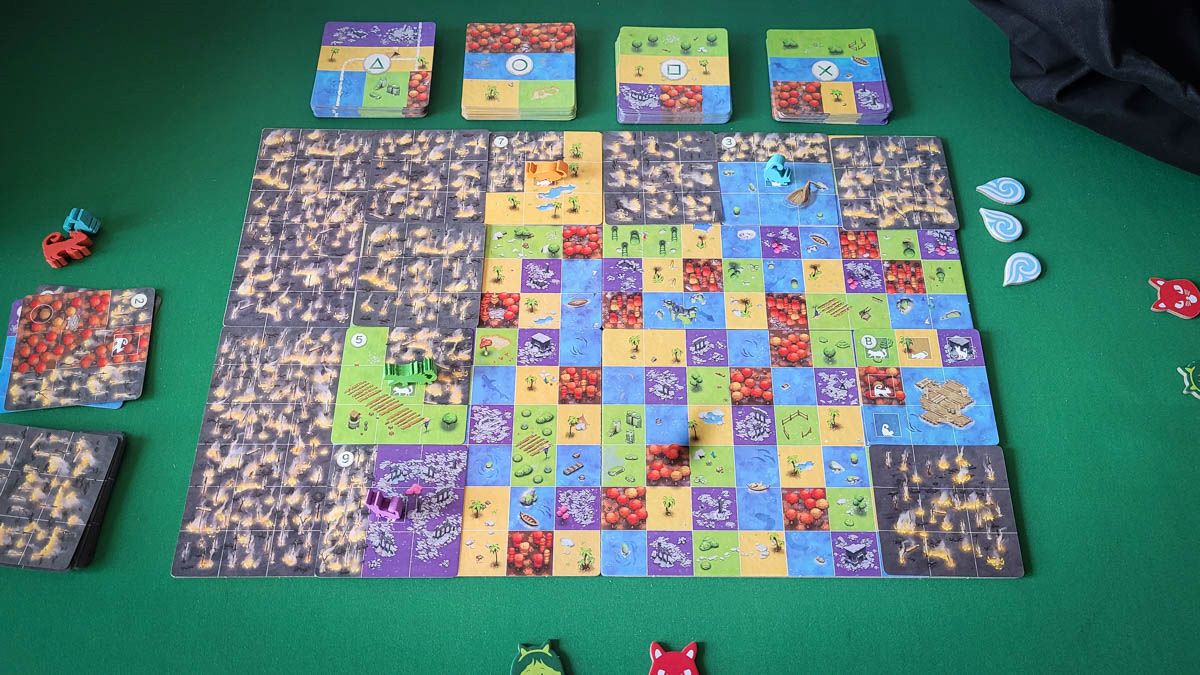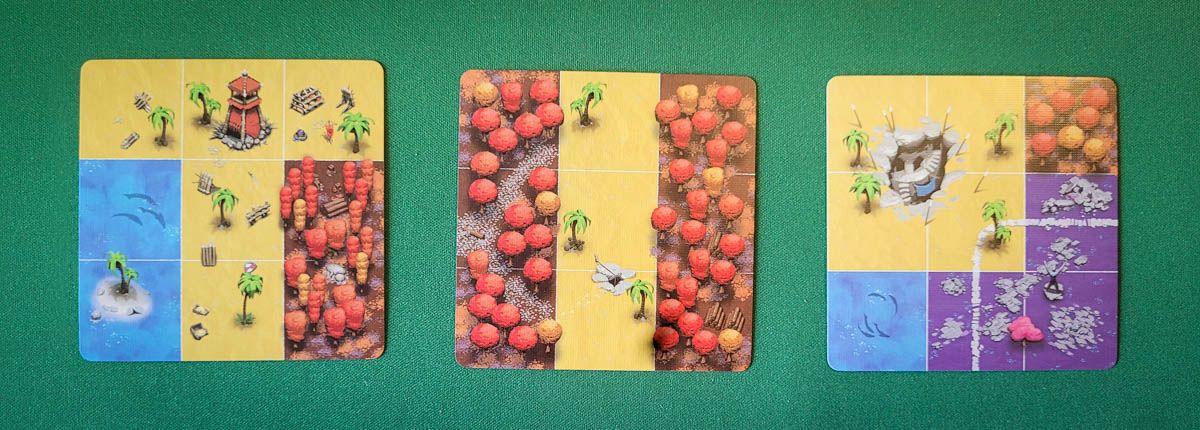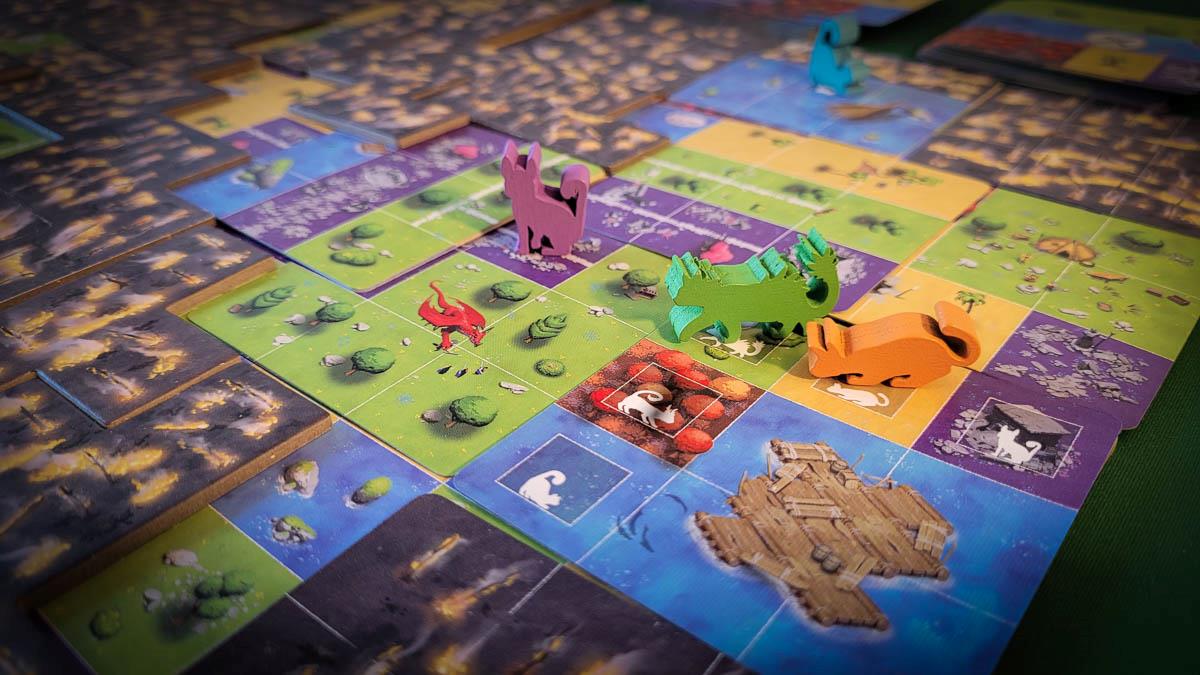Race to the Raft Review
Year: 2023 | Players: 1-4 | Minutes: 40+ | Ages: 8+
This Race to the Raft review was made after playing the game about 10 times. At least one game was played at each player count.
What is Race to the Raft?
Race to the Raft is a cooperative path building game in which you attempt to move cats to a raft before the island they’re on goes up in flames.
Race to the Raft was designed by Frank West and it’s published by The City of Games. This is the second Cats game from West following the popular tile placement game Isle of Cats.
Rules Overview
In Race to the Raft, you and your teammates work together to help cats escape an island. You’ll create pathways for them toward a raft, but you’ll also have to place fire tiles that can limit your future pathway options.
Race to the Raft comes with multiple campaigns, each with multiple scenarios. You can play through a campaign or you can play the scenarios as one-offs.
Each scenario has a unique setup. The campaign book shows you where the initial fire is located, where the cats start, and where the escape raft is.
During a round, each player draws three pathway cards from any of the four decks. Those cards are then either placed on the island to create pathways or used to move the cats.
When choosing cards, you’ll want to check the back of the pathway decks to see which ones give you the best odds of getting the terrain types you’ll need. For example, if the cat you’re trying to move uses the water pathway, you’ll usually want to draw cards from the “X” and “O” decks since those decks have more cards with water pathways in them.
Players can place cards in any order, but this is a limited communication game so you can only say so much about the cards in your hand and you can’t help teammates when they’re placing their pathway cards. There are communication tokens that tweak these rules: the Talk token allows you to give your teammate advice on pathway card and fire tile placement, and you can use the Meow token to try to help a teammate by “meowing” at them.
There are some placement rules, the main ones being that you can’t cover fire, the cats, or the raft.
After you place a pathway card, you have to draw a fire tile and put it on the island. The fire tiles are polyominoes of different shapes that must be placed so they’re touching other fire on the island. After the second tutorial, you’ll have three water tokens that you can use to remove fire tiles if you get in a bind, though you will lose points for using them.
If you want to move a cat, you place a pathway card off to the side and move the cat along its favored terrain (each cat can only be moved once per round). When there are four cards set aside in this way, you discard those cards, draw a fire tile, and place it on the island. In the advanced scenarios, you’ll instead draw a disaster card and resolve it.
You’ll beat a Race to the Raft scenario if you’re able to get all of the cats to the raft.
You’ll lose if (1) you can’t legally place a fire tile, (2) if there is no longer a way to get a cat to the raft, (3) if you need to draw a fire tile and there are none left in the bag, or (4) if there aren’t enough pathway cards for everyone to draw three at the start of a round.
The rulebook includes scoring rules so you can keep track of your high scores and track your campaign scores.
Those are the basic rules for Race to the Raft. More stuff is added in as you play through the scenarios, such as objective tokens, unique location card rules, and a special cat (Oshax) that follows a path rather than a specific terrain type.
Pros and Cons
Pros
- It’s awesome that Race to the Raft comes with scenarios for people of all skill levels. If you’re good at puzzles, there are some very challenging scenarios in the book; I mean, you could remove the communication restrictions and they’d still be tough. If you’re playing with kids or you just want to play on a lower difficulty level, you can stick with the early tutorial scenarios. There are five difficulty levels, so pretty much anyone can find scenarios that work for them.
- There are plenty of fun and interesting choices to make. Choosing which pathway cards to take is a huge decision that can be the difference between winning and losing. Choosing where to place those cards is also huge because you could help or mess up your teammates.
- I like the game-within-a-game with the fire tiles. It’s very satisfying when you pull a tile that fits perfectly in a spot that is a safe distance away from the cats.
- Having the terrain probabilities on the back of the pathway cards was a cool design choice.
- Race to the Raft has massive replay value. You have to have different strategies for each scenario, and even the individual scenarios are highly replayable since the pathway cards and fire tiles you draw change how you play. Plus, there are even more scenarios online at The City of Kings’ website.
- I always appreciate a unique theme. Saving cats from a burning island is definitely unique!
- I doubt any groups will run into quarterbacking issues while playing Race to the Raft. It’s really hard for anyone to take over since you don’t know everyone’s pathway cards and it’s against the rules to tell other players where to place their cards.
- This game has an excellent, well-formatted rulebook. You come to appreciate the good rulebooks after reading through a lot of bad ones. This is one of the good ones.
Cons
- The luck factor is necessary in this type of game, but it can still be very frustrating when it works against you. You can draw terrible pathway cards and fall behind quickly or draw the absolute worst fire tiles and have very little chance to come back. The water tokens can help to mitigate some of the fire tile luck, but you can’t do much about bad card draws.
- I’m not a big fan of the design of the pathway cards. The different terrains don’t blend together very well, and the look of the island as a whole is just… off to me. It leans more abstract, which is fine, but it would have been great if the whole picture came together a bit better.
- The Meow tokens got old for most of us after a few plays. It was hilarious meowing at each other the first couple of games, but then it got more frustrating and irritating than fun.
- The cards are pretty thin and can shift around on the board as you play. That’s less of a problem once you have fire tiles on them, though.
Final Thoughts
A few tweaks would probably make Race to the Raft an even better all-around game for me, but I’m a big fan of its unique puzzle. Moving the cats to the raft is surprisingly satisfying, and fitting the fire tiles together is a nice tactile experience. Plus, I think it’s just awesome that they included so much content in the box and even more online.
Like a lot of other co-op puzzle games, Race to the Raft feels more like a multiplayer solitaire game than a true cooperative game to me, which is why I think it’s best as a solo or two-player game. It was fine with three and four players, but it’s a smoother game with less downtime with two players.
I should point out that one person in my group absolutely loves this game. It’s actually one of her favorite board games now, mostly because she’s a super-fan of cats and she seems to always like puzzle games. She doesn’t mind the Meow tokens one bit.
If you like puzzle games and/or tile placement games, chances are you’ll have a great time playing Race to the Raft.
- Update: Race to the Raft made it onto the Top Puzzle Board Games list!
Race to the Raft Links
BGG | Amazon | Cardhaus
Thanks for taking the time to read our Race to the Raft review!
Be sure to also take a look at our Best Cooperative Board Games list and the other board game rankings.
Subscribe to our newsletter if you want more co-op board game content sent right to your inbox!
[Sassy_Social_Share title=”Share this page”]




